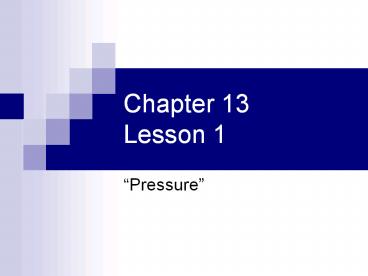Chapter 13 Lesson 1 - PowerPoint PPT Presentation
Title:
Chapter 13 Lesson 1
Description:
Chapter 13 Lesson 1 Pressure I. Pressure A. Def the amount of force exerted over an area. 1. Tires gases push on the outside walls of tires B. Formula ... – PowerPoint PPT presentation
Number of Views:159
Avg rating:3.0/5.0
Title: Chapter 13 Lesson 1
1
Chapter 13Lesson 1
- Pressure
2
I. Pressure
- A. Def the amount of force exerted over an
area. - 1. Tires gases push on the outside walls of
tires - B. Formula - P F / A
- C. Measured in Pascals (N/m2)
- 1. 101.3 kPa at Sea level
- 2. 1000 Pa 1 kPa
3
- D. Our Atmosphere
- 1. Gas layer that covers the earth.
- 2. Perfect amount of gases
- a. Nitrogen 78
- b. Oxygen 21
- c. Carbon Dioxide - .04
- d. Water vapor, dust, argon
- 3. Air pressure ?s as altitude increases
- (Indirect)
4
- E. A book has a force of 30 Newton's while
resting on a table. If the area of the book is
0.06 m2, how much pressure does the book exert? - P F / A
- 30 N / 0.06 m2
- 500 Pa
- Or 0.5 kPa
5
Chapter 13Lesson 2
- Forces and Pressures in Fluids
6
I. Pascals Principle
- A. Def a pressure applied to a fluid is
transmitted throughout the whole fluid. - 1. Squeezing toothpaste
- 2. Squeezing one end of a
- balloon
- B. Hydraulic Machine uses oil like liquid to
multiply input force up to 10x.
7
II. Bernoullis Principle
- A. Def as the velocity of a fluid increases,
the pressure of the fluid decreases. - 1. Ex blowing 2 pop cans.
8
- 2. Airplanes (pg. 213)
Low Pressure
High Pressure
High to Low causes lift for an airplane
9
- As the airplane speeds down the runway, air
rushes over and under the wings. The air, going
over the wings, goes faster and faster, there is
less and less pressure above the wings. Soon
there is much more pressure below the wings than
above. This pressure pushes up on the wings and
the airplane is lifted into the sky.
10
DEMO
- -Fill a beaker or cup full of water to the brim.
- -Add one drop of food coloring
- -Insert a straw to the middle of the beaker
vertically. - -Blow across the top of the straw. Notice the
water inside of the straw. - -What happens and why?
11
- 3. Venturi Effect
- a. Def reduced air pressure outside of
skyscrapers has caused windows to be blown out.
12
High Pressure
High Pressure
Low Pressure
13
- 13.2 Assignment Write a paragraph for why a
curve ball in baseball demonstrates the
Bernoulli Principle.
14
Chapter 13Lesson 3
- Buoyancy
15
- What Archimedes realized about buoyancy
Archimedes solved many problems for King Heiro of
Syracuse. His most famous solution is associated
with Heiro's new crown. Heiro had given the
goldsmith the exact amount of gold needed for the
crown. After it was made, Heiro suspected that it
might not have as much gold as it was supposed
to. King Heiro summoned Archimedes, and
Archimedes was bewildered with the king's
problem. But later, when Archimedes got into his
full bathtub, it occurred to him that the volume
of water that spilled out of the tub was equal to
the volume he displaced. Reasoning that a much
lower volume of water would be displaced by
something denser (like gold) even though of equal
weight, he saw the answer to the king's problem.
The next day Archimedes told they king of his
discovery. Archimedes put the king's new crown in
a tub of water and found that the crown indeed
displaced more water than the same weight of gold
(it occupied more volume because it had been
adulterated with lower density silver). The
goldsmith was immediately beheaded.
16
- I. Buoyancy
- A. Def the ability of a fluid to exert an
upward force on an object placed in it. - 1. results in an apparent loss of
_________ - ? easy to lift
- ? opposite of gravity
- B. History
- 1. Archimedes's Principle
- ?the buoyant force on an object is equal to
the weight of fluid displaced by the object.
Weight
17
- In other wordsthink of the clay activity we did
earlier in this chapter.
18
- C. Two Ways to tell if an object can float
- 1. Density
- gt 1
- lt 1
- 2. Force Analysis
- ? weight vs. buoyant force
- weight gt buoyant force
- weight lt buoyant force
sink
float
sink
float
19
- weight buoyant force
- suspended
20
Quiz Review Content
- Know Pascals Principle and what it applies to.
- Know the pressure equation and units
- What is the definition of a fluid?
- What is the relationship between altitude and
pressure? - Know Bernoullis Principle and what it applies
to. - Know what the Venturi Effect is.
- Be able to calculate force, area, and pressure.
SHOW YOUR WORK!!!!! - There is also an extra credit question on the
quiz, but you will have to get it right to get
the extra credit.































